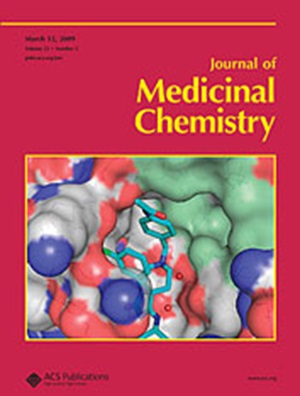药物化学教育:从分子层面了解所有药用特性和创新策略
IF 6.8
1区 医学
Q1 CHEMISTRY, MEDICINAL
引用次数: 0
摘要
欲知未来,先学过去。- 孔子 图 1.基于专业知识的药物化学职业过渡。药物化学--从分子层面了解外源分子在人体中的作用以及人体对外源分子的作用。考虑 P3 特性--药效学、物理化学(与 ADMET 相关)和药代动力学特征。这就要求改变传统的 "结构-活性关系"(SAR),转而采用全面的 "结构-功能关系"(SFR)方法来考虑新研究分子的所有 P3 特性。对药物功能、治疗方案、临床候选药物的重要分子医学洞察。药物注释》和《药物化学杂志》上发表的《专利亮点》对教学很有帮助。联合疗法对网络多药理学的干扰。分析疗效与药物不良反应(ADRs)和耐药性问题相关的分子机制。在设计和发现新型治疗药物时,可引入 "medicinophores "知识。负责改善所研究分子主要药用特性的结构基团可称为 "药性团",而药效团则负责配体与生物大分子的结合,发色团代表材料中吸收特定波长可见光并因此反映材料颜色的分子部分、基团或原子。在药物发现工作中,采用创新思维和假设驱动的设计原理,实施一系列以特性为重点的策略。基于计算机的预测:人工智能、ML、DL、基于聚类的分析、分子对接、分子动力学、各种理化性质过滤器以创造分子药用价值,以及分子理化性质描述符。化学反应、试剂、工艺、化学(有机)合成逻辑、逆合成、反应方法和合成途径的开发、分子多样性的获取以及后期功能化。绿色合成、绿色化学原理、绿色试剂、溶剂和方法以及衡量标准。知识产权和专利法。生物物理研究,用于评估生物/药物特性和体外检测方案、结构功能优化和体内实验。在药物发现过程中使用先进科学(分析、光谱和其他)仪器的知识。亲身体验实验,获得实验室和研究技术方面的技能,并实际接触课程内容。通过以特定治疗问题为重点的研究项目,设计、合成和发现新的生物活性制剂,或在制药行业进行药物发现 R&D 实习,获得实际研究经验。本文尚未被其他出版物引用。本文章由计算机程序翻译,如有差异,请以英文原文为准。

Medicinal Chemistry Education: Molecular Level Understanding of All Medicinal Properties and Innovative Strategies
Study the past if you would define the future. – Confucius Figure 1. Expertise-based career transitions to medicinal chemistry. Medicinal chemistry – a molecular level understanding of what an exogeneous molecule can do in the human body as well as what the body can do to the exogeneous molecule. Consideration of P3 properties – pharmacodynamics, physicochemical (ADMET-relevant), and pharmacokinetic profile. This requires a change from the conventional “structure–activity relationship” (SAR) to a comprehensive “structure–function relationship” (SFR) approach to all P3 properties of new investigational molecules. Critical molecular medicinal insight into the function of drugs, treatment regimens, clinical candidates. Drug Annotations and Patent Highlights published in the Journal of Medicinal Chemistry are useful to consider for teaching. Combination therapy to network polypharmacology interference. Analysis of molecular mechanisms associated with efficacy versus adverse drug reactions (ADRs) and drug-resistance issues. In the design and discovery of novel therapeutic agents, knowledge of “medicinophores” can be introduced. A structural motif that is responsible for improving major medicinal properties of investigated molecules can be termed as a “medicinophore”, while a pharmacophore is responsible for ligand-binding to biological macromolecules, and a chromophore represents a molecular part, a group, or an atom in a material that absorbs a particular wavelength of visible light and as a result reflects the color of the material. A range of property-focused strategies with innovative thinking and hypothesis-driven design rationale in drug discovery efforts. Computer-based predictions: AI, ML, DL, cluster-based analysis, molecular docking, molecular dynamics, various filters for physicochemical properties to create molecular medicinal value, and molecular physicochemical property descriptors. Chemical reactions, reagents, processes, logic in chemical (organic) synthesis, retrosynthesis, development of reaction methods and synthetic approaches, access to molecular diversity, and late-stage functionalization. Greener syntheses, green chemistry principles, greener reagents, solvents, and methods, and metrics. Intellectual property rights and patent law. Biophysical studies for evaluation of biological/medicinal properties and in vitro assay protocols, structure–function optimization, and in vivo experiments. Knowledge of using advanced scientific (analytical, spectroscopic, and others) instruments in drug discovery. Hands-on experience with experiments to gain skills in laboratory and research techniques and practical exposure to course contents. Real-life research experience through research projects focusing on particular therapeutic problems and the design, synthesis, and discovery of new bioactive agents or internships for drug discovery R&D experience in the pharmaceutical industry. This article has not yet been cited by other publications.
求助全文
通过发布文献求助,成功后即可免费获取论文全文。
去求助
来源期刊

Journal of Medicinal Chemistry
医学-医药化学
CiteScore
4.00
自引率
11.00%
发文量
804
审稿时长
1.9 months
期刊介绍:
The Journal of Medicinal Chemistry is a prestigious biweekly peer-reviewed publication that focuses on the multifaceted field of medicinal chemistry. Since its inception in 1959 as the Journal of Medicinal and Pharmaceutical Chemistry, it has evolved to become a cornerstone in the dissemination of research findings related to the design, synthesis, and development of therapeutic agents.
The Journal of Medicinal Chemistry is recognized for its significant impact in the scientific community, as evidenced by its 2022 impact factor of 7.3. This metric reflects the journal's influence and the importance of its content in shaping the future of drug discovery and development. The journal serves as a vital resource for chemists, pharmacologists, and other researchers interested in the molecular mechanisms of drug action and the optimization of therapeutic compounds.
 求助内容:
求助内容: 应助结果提醒方式:
应助结果提醒方式:


